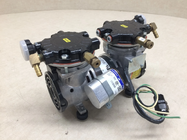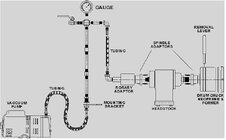I own two Gast Model 0523 rotary vane pumps, both of which are "dry" oil-less pumps that run both cool and quiet for long periods as necessary (mine are rated for continuous duty). Depending on your system filtering and installation, infiltration of fine dust that invariably gets drawn into the system gets in contact with the oil of the lubricated head, and will, over time, accumulate all manner of gunk (technical term) in and around the vanes, and in the input and exit ports at the top of the pump head. The internal filters (if installed) also get clogged with dust-oil mix and need to be cleaned periodically. Been there. Done that. Also, aerosol oil exiting the pump also creates a mess, which is one of the reasons the "hanging" external filters are in place. Outflow air still can create a nice mess of oil in proximity of where the pump is installed.
Both of my pumps are oil-less and have not given me any problems with my vacuum chucking systems which have been working (fairly frequently) for over 7 years. The likelihood is that the pumps will not have any issues until the vanes are worn to the point when the pump no longer pulls the rated vacuum.
My recommendation is to keep looking for oil-less (i.e. carbon-composite vane) pumps which (as the Model 0523 specs state) will pull ~5 cfm at 26" Hg. Many of the medical replacements (some hospitals, etc. are required to replace their equipment at specific use/time intervals) of these vacuum pumps are used for aspirators and other applications, where having oil-lubricated pumps are not an issue. In the fine-dust environments we turners live in, infiltration of dust into the pump IS an issue, and one that can be avoided with obtaining a pump with a dry-vane design.
I have been re-building Gast, Sargent-Welsh, Fisher, Alcotec (and other) vacuum pumps since the late 1970s as the "lab rat Mr. Fix-it" of most of the research labs I have worked in, and I can tell you that it is a major PITA to have to strip down a pump head and clean it periodically. If replacement parts are needed, rebuild kits can be pricey. Try to avoid this if you have the opportunity, and look for a dry-vane pump. (BTW - I would rate $250 for one of these pumps as a so-so price even when compared to comparable units on eBay). There are some excellent bargains out there on dry-vane 0523's (or even 0823's), so don't give up looking. Be sure the motor voltage is what you want (some 220V units are often sold from industry from things like printing presses and graphics studios), and be sure the motor voltage is compatible with your installation voltage, since you probably don't want the added expense of additional wiring upgrades costs.
Good luck with installing your system.
I have said for years, "Once you go VAC, you'll never go back!"
Rob Wallace





